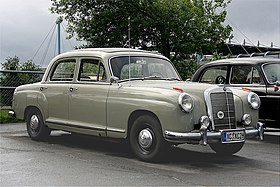This article needs additional citations for verification. (June 2019) |
| Mercedes-Benz W105 219 | |
|---|---|
 Mercedes-Benz 219 (W105) | |
| Overview | |
| Manufacturer | Daimler-Benz (saloons) IMA (estates) |
| Production |
|
| Body and chassis | |
| Class | luxury car (F) |
| Body style | |
| Layout | Front-engine, rear-wheel-drive layout |
| Related | Mercedes-Benz W120/W121 — 180 (D) & 190 (D) Mercedes-Benz W180 — 220a/S Mercedes-Benz W128 — 220SE |
| Powertrain | |
| Engine | 2195 cc M180 II I6 |
| Transmission | 4-speed manual, lever on steering column |
| Dimensions | |
| Wheelbase | 2,750 mm (108.3 in) |
| Length | 4,650 mm (183.1 in) from 8–1957: 468 cm (184 in) [1] |
| Width | 1,740 mm (68.5 in) |
| Height | 1,560 mm (61.4 in) |
| Curb weight |
|
| Chronology | |
| Predecessor | Mercedes-Benz W187 |
| Successor | Mercedes-Benz W111 |
The Mercedes-Benz W105 is the internal designation for a four-door executive car, manufactured by Daimler-Benz from 1956 to 1959, and marketed as the Mercedes-Benz Typ(e) 219. The W105 was nicknamed Ponton, along with its Mercedes model siblings, from its introduction, because it employed ponton, or pontoon styling, a defining post-war car design innovation that unified a car's previously articulated bonnet, wings, body and running boards into a singular, slab-sided envelope.
The Mercedes 219 (internally W105), had a 2.2 L inline 6-cylinder engine, and uniquely featured a bodyshell that combined the stretched nose of the more luxury W128 and W180 models 220a and 220 S(E), but shared the regular standard wheelbase cabine, with shorter rear doors, with the 1953 entry-level 4-cylinder Mercedes W120/W121 models 180 and 190, to offer an intermediate no-frills 6-cylinder model option.